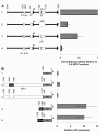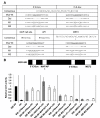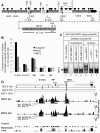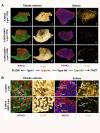Differentiation and fiber type-specific activity of a muscle creatine kinase intronic enhancer
- PMID: 21797989
- PMCID: PMC3157005
- DOI: 10.1186/2044-5040-1-25
Differentiation and fiber type-specific activity of a muscle creatine kinase intronic enhancer
Abstract
Background: Hundreds of genes, including muscle creatine kinase (MCK), are differentially expressed in fast- and slow-twitch muscle fibers, but the fiber type-specific regulatory mechanisms are not well understood.
Results: Modulatory region 1 (MR1) is a 1-kb regulatory region within MCK intron 1 that is highly active in terminally differentiating skeletal myocytes in vitro. A MCK small intronic enhancer (MCK-SIE) containing a paired E-box/myocyte enhancer factor 2 (MEF2) regulatory motif resides within MR1. The SIE's transcriptional activity equals that of the extensively characterized 206-bp MCK 5'-enhancer, but the MCK-SIE is flanked by regions that can repress its activity via the individual and combined effects of about 15 different but highly conserved 9- to 24-bp sequences. ChIP and ChIP-Seq analyses indicate that the SIE and the MCK 5'-enhancer are occupied by MyoD, myogenin and MEF2. Many other E-boxes located within or immediately adjacent to intron 1 are not occupied by MyoD or myogenin. Transgenic analysis of a 6.5-kb MCK genomic fragment containing the 5'-enhancer and proximal promoter plus the 3.2-kb intron 1, with and without MR1, indicates that MR1 is critical for MCK expression in slow- and intermediate-twitch muscle fibers (types I and IIa, respectively), but is not required for expression in fast-twitch muscle fibers (types IIb and IId).
Conclusions: In this study, we discovered that MR1 is critical for MCK expression in slow- and intermediate-twitch muscle fibers and that MR1's positive transcriptional activity depends on a paired E-box MEF2 site motif within a SIE. This is the first study to delineate the DNA controls for MCK expression in different skeletal muscle fiber types.
Figures





Similar articles
-
Identification of a myocyte nuclear factor that binds to the muscle-specific enhancer of the mouse muscle creatine kinase gene.Mol Cell Biol. 1989 Jun;9(6):2627-40. doi: 10.1128/mcb.9.6.2627-2640.1989. Mol Cell Biol. 1989. PMID: 2761542 Free PMC article.
-
E-box sites and a proximal regulatory region of the muscle creatine kinase gene differentially regulate expression in diverse skeletal muscles and cardiac muscle of transgenic mice.Mol Cell Biol. 1996 Sep;16(9):5058-68. doi: 10.1128/MCB.16.9.5058. Mol Cell Biol. 1996. PMID: 8756664 Free PMC article.
-
Multiple regulatory elements contribute differentially to muscle creatine kinase enhancer activity in skeletal and cardiac muscle.Mol Cell Biol. 1993 May;13(5):2753-64. doi: 10.1128/mcb.13.5.2753-2764.1993. Mol Cell Biol. 1993. PMID: 8474439 Free PMC article.
-
Activation of muscle-specific transcription by myogenic helix-loop-helix proteins.Symp Soc Exp Biol. 1992;46:331-41. Symp Soc Exp Biol. 1992. PMID: 1341046 Review.
-
Muscle mechanics: adaptations with exercise-training.Exerc Sport Sci Rev. 1996;24:427-73. Exerc Sport Sci Rev. 1996. PMID: 8744258 Review.
Cited by
-
Application of ATAC-Seq for genome-wide analysis of the chromatin state at single myofiber resolution.Elife. 2022 Feb 21;11:e72792. doi: 10.7554/eLife.72792. Elife. 2022. PMID: 35188098 Free PMC article.
-
Myogenin recruits the histone chaperone facilitates chromatin transcription (FACT) to promote nucleosome disassembly at muscle-specific genes.J Biol Chem. 2013 Mar 15;288(11):7676-7687. doi: 10.1074/jbc.M112.426718. Epub 2013 Jan 30. J Biol Chem. 2013. PMID: 23364797 Free PMC article.
-
Requirement of Pitx2 for skeletal muscle homeostasis.Dev Biol. 2019 Jan 1;445(1):90-102. doi: 10.1016/j.ydbio.2018.11.001. Epub 2018 Nov 8. Dev Biol. 2019. PMID: 30414844 Free PMC article.
-
Actin nemaline myopathy mouse reproduces disease, suggests other actin disease phenotypes and provides cautionary note on muscle transgene expression.PLoS One. 2011;6(12):e28699. doi: 10.1371/journal.pone.0028699. Epub 2011 Dec 9. PLoS One. 2011. PMID: 22174871 Free PMC article.
-
The Role of Insulin in the Proliferation and Differentiation of Bovine Muscle Satellite (Stem) Cells for Cultured Meat Production.Int J Mol Sci. 2025 Apr 25;26(9):4109. doi: 10.3390/ijms26094109. Int J Mol Sci. 2025. PMID: 40362349 Free PMC article.
References
-
- Lyons GE, Muhlebach S, Moser A, Masood R, Paterson BM, Buckingham ME, Perriard JC. Developmental regulation of creatine kinase gene expression by myogenic factors in embryonic mouse and chick skeletal muscle. Development. 1991;113:1017–1029. - PubMed
Grants and funding
LinkOut - more resources
Full Text Sources
Other Literature Sources
Molecular Biology Databases

